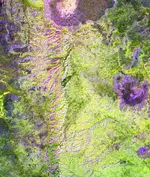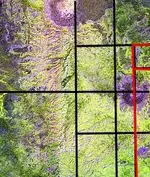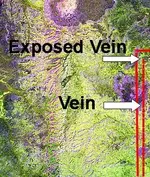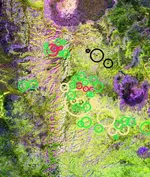For looking for raw surface gold I can use either the Aster or Landsat 7 satellites. The Aster series has 15 different light sensors. For mineral detection/location the Aster series is superior to the Landsat series, for most mineral mapping, because its sensors have a much smaller bandwidth.
Band No. Spectral Range (μm)
1 0.52-0.60 visible range
2 0.63-0.69
3N 0.78-0.86
3B 0.78-0.86
4 1.60-1.70 Near IR range (reflected light)
5 2.145-2.185
6 2.185-2.225
7 2.235-2.285
8 2.295-2.365
9 2.360-2.430
10 8.125-8.475 Extended IR range (from self emission - absorbed heat)
11 8.475-8.825
12 8.925-9.275
13 10.25-10.95
14 10.95-11.65
While the Landsat satellite system also has IR sensore they don't go as far into the IR as do the Aster series satellites. But the Landsat system has higher resolution than the Aster series does but the images are over a gigabyte in size. The 3B sensor is a back looking sensor used to provide 3D views in the visible spectrum.
You can find more about these sensors at this link:
http://asterweb.jpl.nasa.gov/content/03_data/04_Documents/aster_user_guide_v2.pdf
It takes several hours to find a suitable image that doesn't have any clouds in it and then translate and combine the package into a multi-layered image. Then after all this is finished the algorithm can be run in a few minutes (if you have a very fast multi-processor computer).
As far as gold emission goes there are very detailed wavelength tables for gold in the "Handbook of Chemistry and Physics". When you build your algorithm you need to take into consideration the fact that gold laying on the ground does not have a highly polished surface (which exhibits highly directional reflection) but instead the surface is pitted and generally coated with a clear varnish (from being exposed to the elements for years - this coating is so bad when I drop a gold placer into a fresh batch of aqua-rega nothing happened because the acid couldn't get to the gold surface). This pitting usually makes the gold placers/flakes reflect light in a unidirectional directional (failry evenly with angle). Generally a placer will exhibit less than 20% reflection and one that has a thin dust coating under 5%.
An algorithm to find such materials looks for similar emissions/reflections withing 2% between the various bands down to 1 um where the reflection starts to drop (refer to the Handbook of Chemistry and Physics). The reflection of gold continues to drop somewhat evenly across the visible spectrum so the algorithm also looks for the drop ratio between bands 4, 3N, 2, and 1. Such an algorithm is very comples and requires many steps and resulting images.
Another way to build your algorithm is to select four bands and produce maps from the rations of the three products. For this type of algorithm you would divide three IR bands by the lowest visible band (which would be band 1). For this type of algorithm you would use the Landsat satellite system as the Aster series does not have a blue sensor like the Lamdsat does. The ration of the reflectivity for gold between blue light and any of the IR bands is very high. So if you used the Landsat series you would produce an image from the division of band 7 and band 1 (ie: 7/1). Then produce a second image from bands 5 and 1, and a third image from bands 4 and 1. Then assemble these three layers into a single image and assign the 7/1 band as the Red layer, the 5/1 as the Green layer, and the 4/1 image as the Blue layer of the new image. Then the resulting false color image, which will be devoid of most of the topological information, will show surface gold as white dots.
You need to be careful when you analyze these images for you can get white dots over habitated areas (mostly from the trash and junk in peoples yards) but this is generally not a problem in open areas where people don't live or trash.
These images are quite large, generally 300 megs per layer. The division usually requires 30 billion division calculations per layer or over 100 billion calculations to produce a false color image.
If you want to a simple introduction to false color satellite mineral maps start with this link:
Satellite Mineral Images
The gold reflectance algorithm is an extremely simple one that doesn't require and research or testing. Algorithms to find mineral fields are far more difficult to develop.
Another word of caution these satellites can't see anything smaller than 30' so you are looking for an outcropping of a thick vein lode gold deposit they will never see it however they will see the alteration zone where the deposit was formed, so in this case you would not look for gold at all but rather an alteration zone. For micron gold you use yet another different algorithm.
I hope this answered your question.
Roger










